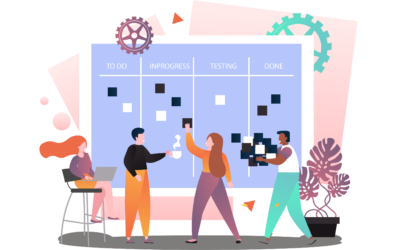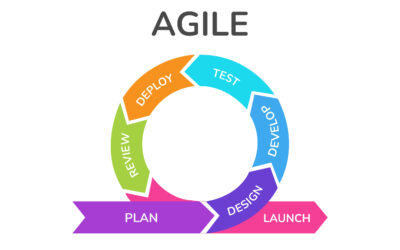Table of Content
Have you ever wondered how today’s organizations work to stay competent and up to date in a world where technology is advancing rapidly and users are becoming more demanding? In this article, we will describe a methodology widely used in the software industry (and increasingly in other sectors) called Scrum, which aims to improve the efficiency and quality of teamwork. We will see how this methodology can help organizations become more agile, respond quickly to change, and deliver high-quality products in the shortest possible time. We will discover what Scrum is and how it is done. If you want to learn more about this methodology and how it can be applied in your organization, read on.
What is Scrum?
Scrum is a term borrowed from rugby. In rugby, the word describes a formation in which players work together to move the ball forward. As in rugby, collaborative work is essential in the Scrum methodology: Teams are encouraged to work together, share information, and support each other to achieve project goals. Scrum is an agile project management methodology used to develop products and services in a changing environment. It focuses on maximizing the value delivered to the customer, fostering collaboration among the team, and continuously improving the work process through inspection and adaptation. This methodology began as a way of working for the software industry. Then, due to its effectiveness, it began to be applied in other fields with equally promising results.
How does Scrum work?
The Scrum methodology is based on an iterative and incremental product and service development approach. By breaking large problems into smaller, more manageable pieces, teams can focus on more specific tasks and increase work efficiency. In addition, Scrum encourages teams to perform frequent inspection and adaptation cycles, allowing them to adjust their approach based on what they are learning in each cycle. This allows them to continuously improve the work process and deliver a higher quality product or service to the customer.
Roles in a Scrum Team
Development Team: The development team comprises people who work together to do the work necessary to deliver the product or service. In the software environment, developers are usually the ones who write code. Still, in Scrum, this team is understood to include all members who contribute to the project, such as designers, testers, analysts, and others. The goal of this team is to work together to create a high-quality product that meets the customer’s needs. Developers are responsible for converting product backlog items into deliverable product increments at the end of each sprint.
Product Owner: The product owner is the person who knows and understands the customer’s requirements. He is responsible for resolving doubts about the product and defining the best way forward for the team. He is also responsible for defending the team and protecting it from external interference, such as sudden changes that are not in line with the team’s objectives. His responsibilities also include: - Prioritizing the product backlog - Deciding which backlog items to include in each sprint - Ensuring that the team clearly understands the sprint objectives and expected deliverables.
Scrum Master: The Scrum Master role is critical to the success of a Scrum team. He is a servant leader who guides the team in adopting the Scrum methodology, including encouraging self-management, inspection, transparency, and collaboration. To this end, the Scrum Master removes obstacles and facilitates effective communication between all team members. They also promote continuous work process improvement and is responsible for creating a safe and trustworthy working environment in which problems can be effectively addressed and resolved. In this sense, the Scrum Master also plays an important role in conflict management, fostering an environment of healthy debate and discussion where difficult issues can be addressed in the pursuit of the project.
Product Backlog
The product backlog is a list of outstanding tasks required to complete the product or service being developed. It is organized according to priorities based on requirements. The product owner is responsible for managing and prioritizing the backlog, but must do so in collaboration with the development team, considering customer needs and environment changes. The development team selects the backlog tasks that can be completed in each sprint according to their capabilities. The product backlog can be updated and adjusted during a sprint to reflect changes in customer needs, the market, and the general environment.
Events in Scrum
Sprint: Sprints are at the heart of the Scrum methodology. A sprint is a fixed event of a month or less in duration. At the beginning of each sprint, the development team selects the tasks from the backlog they are committed to completing. During the sprint, they work intensively and collaboratively to develop the agreed upon work. At the end of the sprint, the completed work is presented. What was achieved is reviewed, what was not achieved is analyzed, and comments and suggestions for improving the process are collected. A sprint aims to divide the work time into manageable periods and to make an inspection in each cycle. This allows the team to better adapt to change and achieve short-term goals.
Sprint Planning: Sprint planning takes place at the beginning of a sprint. It is an event that defines the work to be done during that sprint. The product owner must ensure that the team understands the project goals and priorities before this event so that the team is prepared to discuss prioritization. During this planning session, the product owner and the development team decide which tasks from the backlog to include in the sprint. The development team knows their skills and capabilities, so they can decide how much work to commit to. Sprint planning becomes more efficient and effective as the team gets to know each other and learns to work together more effectively.
Daily Scrum: This is an event that occurs every day during the sprint, preferably at the same time and place to reduce complications. This meeting should last no longer than 15 minutes. During the daily Scrum, progress toward the sprint goal is discussed. The development team can choose their preferred method of conducting these meetings. A common method is for each team member to answer three key questions: What did I do yesterday? What will I do today, and are any obstacles preventing me from moving forward? This ensures that all team members are aligned on the tasks and any possible obstacles. The Scrum Master is responsible for ensuring that the meeting is effective and does not turn into a long discussion session.
Sprint Review: This event is product-focused. It reviews whether the sprint objectives have been met, whether it is on track to meet the project objectives, and what can be improved. Anyone involved in the project (such as the product owner or other stakeholders) is invited to the review to give feedback. This helps to ensure that everyone is on the same page and that the work is meeting requirements and expectations.
Sprint Retrospective: This event focuses on the work process. During a sprint retrospective, the team comes together to reflect on how the sprint was carried out and how the work process can be improved. The sprint retrospective aims to identify what worked well and what did not and to propose solutions to improve the efficiency and quality of the work. It can also be used to discuss issues related to cooperation and communication within the team, such as the distribution of tasks and responsibilities, the quality of teamwork, etc.
Takeaway
Scrum is a versatile project management methodology that has been proven effective in various industries. By emphasizing collaboration, control, and adaptation, Scrum encourages teams to work together efficiently to deliver high-quality products and services that meet customer needs. Its iterative and incremental approach to development allows teams to continuously improve their work process and make adjustments based on what they learn. In addition, the clear roles, events, and tools provided by the Scrum framework help teams stay focused and aligned. While implementing Scrum may require effort, its proven effectiveness and ease of adoption make it a valuable investment for any organization looking to improve its project management approach.










I think it’s essential for teams to review the product backlog before sprint planning to ensure alignment.